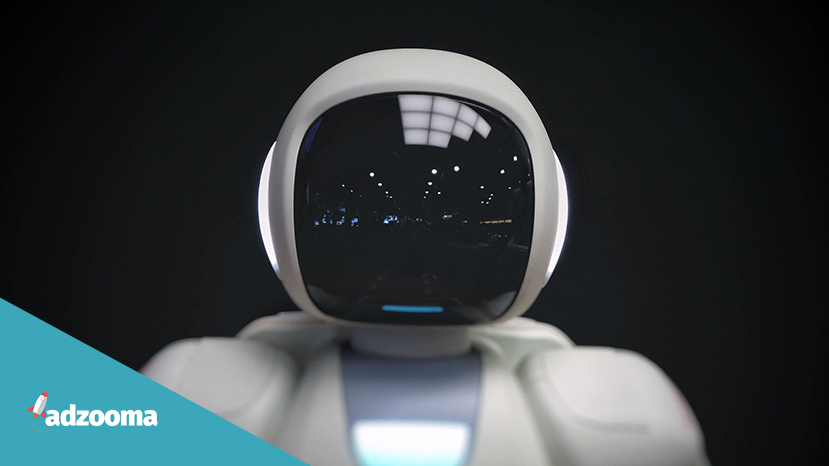Many people view artificial intelligence as sentient robots trying to take over the world. But that’s far from the truth. The fact is, AI exists to improve lives and free up time and resources for tasks that need considered effort from humans. Social media is an area that AI thrives in and this article will look at its influence on the communication channel.
What is artificial intelligence?
Artificial intelligence (often shortened to AI) is a branch of computer science that aims to create machines that automate certain tasks and make them more efficient. AI is used in hundreds of industries around the world in different forms:
- Factories use robots to automate streamline processes and production
- Recruitment agencies use AI in intelligent software which helps to boost productivity
- AI is perfect for forecasting, useful in industries that need data on supply and demands and finding the best time to launch products
Social media users and the platforms themselves use AI extensively. For example, people have been using AI models as “influencers”. One such AI-generated influencer, Miquela, has over 2 million Instagram followers with the kind of feed that’d make a human influencer jealous.
The science of social media networks
When looking deeper into social media networks, you’ll start to see the science behind them. Used as a way to not only identify how users interact but as a method of identifying how companies can target consumers, there are so many elements that go into each application.
The technology
AI can facilitate the sharing of information, thoughts and ideas and give users quick access to content. That includes their own personal information, photos, and documents and content from news feeds.
Facebook, for example, uses a tool called Deeptext to interpret posted content and find its meaning. It does this with machine learning and then provides relevant ads to users based on that content.
Utilising a range of languages and operating systems including Python, PHP, JavaScript, and Linux, social networks can automate processes with increasing ease. It happens so fast, you’d think it was instant.
The psychology
Social media has had a profound effect on psychology. We spend hours scrolling through different pages, wanting to stay up to date with the latest information so we don’t feel left out (known as FOMO). When we post, we rely on three parts of our neural systems, according to a paper by Dar Meshi, Diana I. Tamir, and Hauke R. Heekeren:
- Social cognition (how people process, store, and apply information about other people and social situations)
- Self-referential cognition (how people process, store, and relating information to themselves, usually from external sources)
- Social reward processing (how people process the rewards we get from interacting with people and social situations)
On the topic of social media’s effect on how we think, author Nicholas Carr said:
“What psychologists and brain scientists tell us about interruptions is that they have a fairly profound effect on the way we think. It becomes much harder to sustain attention, to think about one thing for a long period of time, and to think deeply when new stimuli are pouring at you all day long. I argue that the price we pay for being constantly inundated with information is a loss of our ability to be contemplative and to engage in the kind of deep thinking that requires you to concentrate on one thing.”
Nicholas Carr, author of The Shallows: How The Internet Is Changing Our Brains
With these kinds of behaviours, along with other social and emotional influences that are picked up by social media networks, a never-ending AI-influenced cycle continues to spin with its users in the middle.
Customer behaviour
When looking more deeply into how businesses use them, you can clearly see the effect on customer behaviour. Businesses use social network graphs to adapt their social media strategy so that it suits their respective platforms. This, along with a better understanding of the psychology behind interactions and sharing on social media, marketers can develop content that generates higher conversion rates and build trust between them and their client base.
Benefits of AI in social media

Already, you’ll probably be aware of the ways in which social media marketing can benefit your business. But by effectively using AI in social media, there is a whole host of other benefits that you can take advantage of.
Automation
One of the biggest advantages of using AI in social media is its automation capabilities. Whether this is in automating content creation, content curation or another process, it will make your business far more productive. How? Well, not only will it speed up processes so that it can be ‘delivered’ to customers far quicker, but it will give your employees more time to spend on other aspects of their roles.
Other examples of tasks to automate in social media management:
- Social listening
- Social engagement
- Content scheduling
- Content republishing
- Analytics tracking
If you’d prefer not to use a tool, you can always use a social media marketing service to do it for you and many of the best agencies use AI at the core of their processes.
Measuring of performance
Another huge benefit of AI in social media is that it allows marketers to analyse and track every step that they take. From identifying the performance of an ad to tracking user-engagement and invaluable insights into content, it’s an advance in technology that businesses appreciate. Tools like Hootsuite, for example, give powerful insights to users about their customers and their choices.
But be warned: AI isn’t perfect. The data it uses comes from humans and if there’s any bias in the inputted data, there’ll be bias in the output.
Optimised content
As mentioned above, AI can do a great job of optimising social media content thanks to machine learning. By learning from the generated data, ML systems can create high-quality patterns that better content in the future.
How is AI used in social media?
AI is a key component in almost every social media network today. Let’s dive into how Facebook, LinkedIn, Instagram and Pinterest utilise it in further detail:
Facebook uses a variety of AI tools to heighten each user’s experience. Not only can they use that data to generate suggestions, but through machine learning, they use facial recognition that allows tag suggestions. This is particularly useful for businesses that want to target customers to gain recognition and gain publicity.
LinkedIn is another social media network that has long been using AI in their everyday processes. Its technology provides connection suggestions, targets posts to users, offers specific job recommendations and showcases better candidates for employers.
LinkedIn Talent Solutions is LinkedIn’s employer “marketplace” where they can find potential candidates for their job listings. Using AI with its LinkedIn Recruiter product, it creates “talent pools”.
The first way that Instagram uses artificial intelligence is seen on its Explore page. Picking up trending posts and stories due to the hashtag that’s used, it presents them to you in a neatly wrapped package.
In 2016, the company changed its algorithm so its news feed was more value-based, rather than chronologically ordered, although that change has proved controversial. In its current format, the algorithm is optimised for each user, based solely on their preferences.
The main reason why so many users love Pinterest is because of the personalised content that it shows. An aspect that requires AI to work, without it, it’s fair to say that the network wouldn’t be as successful.
However, another example of how they use AI is through the new feature – Pinterest Lens. Through this application, it allows users to take a photo. Once this action is carried out, aspects of it are decoded, from the shape to colours. Based on the information gathered, it shows related results to the user.
The algorithms of social networks

Each social network uses a different algorithm and although we’ve briefly touched on these above, let’s go into a bit more detail.
Starting with Facebook, throughout the years their algorithm has changed depending on certain factors including trends and the demands of their users.
After recent changes, Facebook announced they wanted to use ranking signals in order to increase customer engagement. The overarching algorithm takes into account a user’s past behaviour through who they interact with, the media they post and how popular it was. Making the platform more transparent, they are now offering user’s more control over what appears on their homepage.
For Instagram alongside utilising AI within their algorithm to showcase trending posts on the home page, they also introduced a way of identifying spam and comments that are thought to be harmful.
This is done through the aforementioned DeepText technology. Moderating the content, it’s a step that’s valuable to both everyday users and marketers as it means that only genuine users can find their page. This is particularly important at the moment, as so many fake followers and trolls are constantly on the networking site.
Another feature that Pinterest introduced within their algorithm is PinSage. Based on neural networking, it ensures that every search you enter is related to the particular theme that you wanted to find. Not only is this convenient to users as it only shows them useful content, but for businesses as they are able to post content with high ranking keywords.
Competitive analysis
Businesses post on social media a lot – it’s just a fact. And because of this, it makes it easy for their competitors to create content based upon what content is already out there.
For example, if you’re thinking of creating a social media post, you could go onto your competitor’s page to see what they have already done. Staying ahead and countering their efforts, you can remain on top.
But as well as traditional social media monitoring tools (e.g. as a tool that alerts you when a business uploads a particular post), you can now use tools that have AI built-in. These give you the benefit of being able to identify any complaints on posts as it captures every social media post surrounding your competitor.
Social listening
Another element of social media in which AI is making a big impact is social listening. To put it simply, social listening is a technique that’s used to monitor a business’ social media channels. Picking up any mentions of the brand, related discussions or customer feedback, it’s something that’s available to do on all social media networks.
Through social media listening tools, organisations are able to efficiently analyse millions of conversations and effectively identify any patterns within the data. They can then use these insights to inform their customer service efforts, product development and overall marketing strategy.
A more efficient way of discovering this information, it’s replacing more traditional methods such as interviews and surveys.
Linking with this, is how AI can measure social sentiment. Through the use of Natural Language Processing (NLP) and computational linguistics, social media is able to analyse all of the social data it collects.
Image recognition
Image recognition technology that has AI within it will efficiently detect a brand’s exposure and allow for better metrics. Enabling companies to increase their visual appeal and aesthetic to customers on a more personal level, it increases engagement in the long run.
A technology that’s looking to transform social media marketing, it’s one that you shouldn’t ignore.
AI in social media analytics
Businesses will be pleased to know that there is now a variety of tools available that use AI in order to analyse social data. From consumer intelligence platforms to consumer feedback analysis tools, these enable businesses to gather the data before learning from it.
A web tool that shows exactly which social sites are driving the most traffic to your website, it will also help you to make long-term goals and make intelligent decisions – things that will benefit your company, as it could lead to higher revenue and profits.
Natural language processing (NLP)
NLP is a branch of AI centred on the interaction between humans and computers using natural language. Google is a major proponent of NLP and has an API for people to test it out. It allows not only for translation and word processing but to enable social listening, for the extraction of information and for customer service chatbots amongst other useful tools. Assisted by sentiment analysis, it allows businesses to market products more effectively.
Improves influencer strategies
Lastly, AI can be used within social media as a way of improving influencer strategies. A popular and effective marketing technique within the industry, it aims at boosting ROI and organic reach. But is only effective when it’s used correctly.
So how is AI helping with this? Well, AI allows marketers to choose influencers that are suitable to promote their products. Scanning through the millions that are available on the social media network, it makes the process far quicker. Something that’s essential along with regular management, you’ll know that you’re on the way to a successful influencer strategy that generates leads.
Need help with your social media?
Managing your social media platforms can be quite a time-consuming task. Here are our top social media management companies/tools that you can use to help:
Final thoughts
Those are just a few examples of how AI works behind the scenes to influence social media networks. Something that will continue to change as the technology develops and evolves, the future is exciting for any business that’s harnessing it.
A fundamental part of how you increase customer engagement, generate leads and grow your brand, without it, it’s clear that your influence within the network would not be as powerful.




